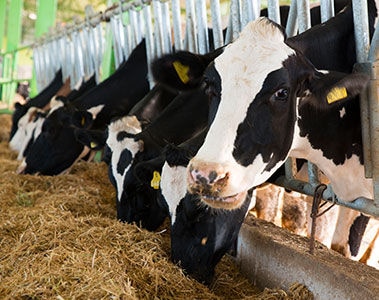
-
Global/EN
- Global
- North America
- Latin America
The National Research Council (NRC) lists requirements for vitamins A, D and E in their seventh revision of “Nutrient Requirements of Dairy Cattle,” published in 2001. Supplemental D is listed as 21,000 IU per day for Holsteins, 13,500 IU for Jerseys, with most of the supplementation coming from the D3 (cholecalciferol) source.1
Vitamin D is responsible for calcium and phosphorus homeostasis in transition cows, with positive roles in mineral absorption and bone deposition, and conserving both calcium and phosphorus at the kidney. The stakes are high – 98 percent of the body’s calcium is stored in the skeleton, and cows need to mobilize this calcium from the bones in a timely fashion to support the production of colostrum and milk, to supply calcium for nerve and muscle function, and to maintain their health during the transition phase. Adequate vitamin D supports calcium absorption from the ration, storage in the skeleton and retention over time.
There can be. High-producing dairy cows make major metabolic adjustments in the transition phase in order to support a profitable lactation. Thanks to modern management practices such as dietary cation anion difference (DCAD) monitoring and strategic mineral management of forages and other ration ingredients, occurrence of clinical milk fever is rare, especially in younger cows. However, the incidence of subclinical (and clinical) milk fever increases with age and number of lactations. A majority of older high-producing cows mobilize enough calcium from their skeleton in early lactation that they experience subclinical hypocalcemia, and then can’t catch up with their skeletal calcium storage for the rest of the lactation.
Figure 1 demonstrates an irreversible loss of about half a pound of calcium from a skeleton which initially contains 14 lb in a 1320-lb cow. This “lactational osteoporosis” referred to in the Dairy NRC (2001) may not be harmful in one lactation, but over time can deplete the skeleton of calcium and phosphorus, resulting in more incidences of subclinical hypocalcemia.
Unsupplemented cows obtain most of their vitamin D either from plant-based ergocalciferol (D2) or from sunlight exposure on skin, which converts cholesterol to 7-dehydrocholesterol, a D3 precursor. Main supplemental sources include D3 and recently as a new source, 25-OH D3.
As a prohormone, D3 must first be activated through a hydroxylation step in the liver to 25-OH D3, and then by a second step in the kidney to the active hormone form: 1,25-OH2 D3. In the bloodstream, 25-OH D3 is the main circulating metabolite of vitamin D, and now can also be fed directly — see Figure 2. In addition to the kidney, many tissues can utilize 25-OH D3 to synthesize the active 1,25-OH2 D3 form, including gut epithelium, vascular cells, muscle, and immune cells.
1NRC. 2001. Nutrient Requirements of Dairy Cattle. 7th rev. ed. Natl Acad. Press, Washington, DC.
2McGrath, J.J., D.B. Savage and I.R. Godwin, 2015. The role and potential advantages of vitamin D metabolites in maintaining calcium status in high-producing dairy herds. Anim. Prod. Sci, online: http://www.publish.csiro.au/an/AN14450
01 November 2020
Mark Engstrom is a Ruminant Technical Service Manager and HyD Category Manager. He holds a PhD in Nutrition obtained at University of Wisconsin.
Mark has 40+ years of experience in Animal Nutrition and Technical Services, and specializes in vitamins and all aspects of ruminant nutrition.
Not all products are available in all markets nor associated claims allowed in all regions (including but not limited to USA and Canada).
We detected that you are visitng this page from United States. Therefore we are redirecting you to the localized version.